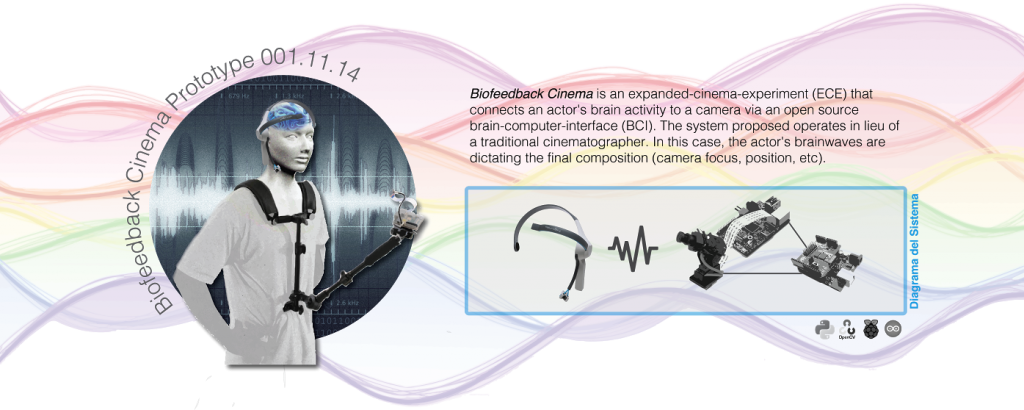Find below a few of the 27 articles I’ve authored for The Ohio State University’s daily student newspaper, The Lantern.
Brussels terror attacks have global, OSU impact – *front-page story
March 29, 2016
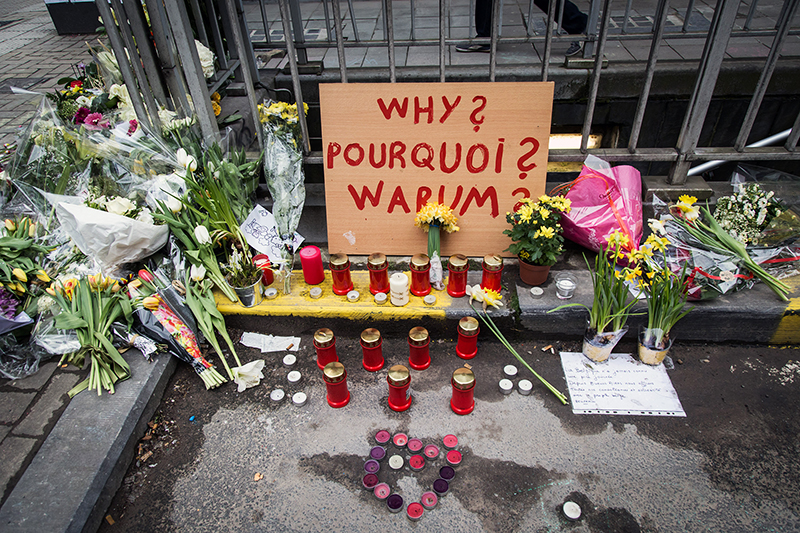
Although the deadly attacks in Brussels on March 22 occurred 4,055 miles away from Ohio State, the community still feels the effects.
The airport and subway bombings in Brussels injured 270 individuals and claimed the lives of 35. They appear to have been carried out by the same Islamic State network that implemented last year’s terrorist attacks in Paris, which killed 130 people.
One OSU student was in Brussels when tragedy struck: Kate Hartmann, a doctorate student in the College of Medicine’s Biomedical Sciences Graduate Program. Hartmann was in the city from March 19 to 23 for a string of meetings with the European Organization for the Research and Treatment of Cancer to discuss a research proposal she put in for a Fulbright Scholarship.
She said she was on her way to the same Brussels airport where a bombing had taken place just minutes earlier when she heard news of danger on the radio while riding in a cab. She had the driver turn around and take her to a hotel, where she was able to contact friends and family to let them know that she was all right.
“I left for the airport around 8 a.m., and that’s when the explosion went off,” Hartmann said. “I was very lucky with the timing of things.”
She decided not to make any moves that day, and was able to make it back to the U.S. by the following night by taking a flight out of Amsterdam. During her time in Belgium, Hartmann said she experienced people opening their homes, offering rides and reaching out to one another.
“I would hope that Americans would act the same way I saw the Belgian people acting: with care, concern and a lot of respect for one another,” she said. “This was horrible and tragic and something to be mourned, but it’s also something to move through and be proud of how your community handles that.”
Although it was a frightening experience, she said it won’t make her wary of further international travel.
“At the end of the day, it’s an active choice that I’m making to not let fear keep me from exploring and knowing the world,” Hartmann said.
Zac Barnett, a fourth-year in political science, also said he’s not hesitant to travel abroad given the current terrorism landscape.
“I think that now more than ever it’s important to travel internationally,” Barnett said. “Right now, many people want to clamp down against this faceless other, and that’s the worst thing we could possibly do. What we should be doing is trying to connect with all people.”
This sentiment was echoed by Hartmann, who said that it’s important for Americans to believe in the goodness of people and to try and not let hatred and anger prevail.
“Lawmakers in the U.S. need to resist the easy temptation that they have to resort to Islamophobia and blame an entire religion for the acts of a very, very small minority,” Barnett said.
He added that most of these individuals don’t deserve to be treated like suspects.
In the aftermath of 9/11, the War on Terror created a narrative that the U.S. — along with the rest of the West — is constantly under threat by people who despise this way of life, said Emma Fete, a graduate teaching associate in the School of Communication who instructs a media and terrorism course. Fete stressed the importance of examining terrorism through larger historical and cultural lenses.
“We act like we’re in this age of terrorism that is new to everybody,” she said. “But the real truth is that terrorism has been around since the French Revolution and in the modern way that we know it.”
Terrorists throughout the ages have relied on the media to send their messages, Fete said, and news outlets must perform an ongoing balancing act of giving the public information and trying to hinder terrorism.
Both Fete and Barnett expressed regret over the terrorist events in non-Western countries that don’t receive half as much attention as those in Brussels or Paris.
“As horrible as these attacks in Paris and Belgium were, there were attacks in Burkina Faso, in Kenya, in Somalia; there was an attack in Iraq a couple of days ago,” Barnett said. “And we don’t talk about this ever.”
On Sunday, an apparent suicide bomb killed 72 people and wounded 300 at a park in Lahore, Pakistan.
OSU’s European Architecture Studies program is the only study abroad group scheduled to stop in Belgium this year, and they will depart in May.
Photographer and cellist explore aesthetic of industry within nature
February 25, 2015
Nestled a mile and a half upstream from the Ohio River in Cheshire, Ohio, lies the Gavin Power Plant. The plant consumes over 25 thousand tons of coal a day, making it the largest coal fired power facility in Ohio. But to photographer Mitch Epstein, it’s also art.
Epstein and cellist and composer Erik Friedlander are set to collaborate in the Wexner Center for the Arts’ upcoming show, “American Power,” an audiovisual act centered on Epstein’s photo series that surveys how the American landscape is affected by various power sources.

During 2003-08, Epstein traveled to 25 states across the U.S. taking pictures of power sources such as dams and nuclear, coal-fired and alternative-energy power plants, among others and their surrounding landscapes, he said.
Although the photos might evoke notions of the mass environmental impacts that man-made power sites can have, both Epstein and Friedlander noted that neither the images nor story have a specific message or intent.
“It’s easy to make a picture that conveys, ‘This is troubling,’ or ‘We should be doing this a different way,’ but that isn’t the purpose of these pictures,” Epstein said. “It’s to illuminate what I see, but also to allow for beauty to be an element … because these landscapes can still be beautiful, even if they’ve been harnessed to satisfy certain needs that we’ve extracted from it.”
The show includes about 100 images accompanied by a live, partly improvised cello part played by Friedlander, video segments and Epstein’s narrative of how his photos came to be, chronicling his methods, challenges and overall journey.
The performance not only fixates on the ideas of electrical power, but political power as well, said Jennifer Wray, marketing and media assistant at the Wexner Center for the Arts.
“In some ways, it’s reminding us to be more cognizant of very simple things, like being able to power on a phone or to have heat,” Wray said. “And also of the people in positions of government and corporate power who make day-to-day decisions that guide our lives — for better and for worse.”
Epstein first began “American Power” after being commissioned in 2003 to Cheshire, a small town along the Ohio River that lies in the shadow of a large, coal-fired power plant. He said the experience of taking photos in Cheshire lingered with him, compelling him to further examine the relationship between American energy reserves, culture and the environment.
“I didn’t set out to do this project as a political work per say, but there were certain relations to the political times,” Epstein said. “In 2008, the era of George W. Bush and Dick Cheney was coming to an end, and both of them had a lot to do with the control of our energy policies.”

Getting the photos wasn’t always easy for Epstein, he said, noting that he had particular trouble getting access to nuclear power plants and in small towns, as he stuck out with his antiquated, large-format camera.
“It was not uncommon for me to be called into question about what I was doing, or to be told I wasn’t allowed to take pictures on public property, although it was within my constitutional rights,” Epstein said. “But I think that the anxiety I was carrying with me … propelled me forward in a way that made me even more uncompromising to my own artistic will.”
The photos were first published in a traditional book format in 2009, and in 2011, Epstein received the Prix Pictet award, a global prize given annually to a single photographer for work revolving around issues of sustainability. He said by the time he was asked to publicly accept the award, he had already shown his images on multiple accounts and wanted to do something different. He contacted Friedlander and gave him the creative freedom to “respond to the photos.”
“The music that he composed in response to the work in some way took the whole series to another place,” Epstein said. “All of a sudden it was this new entity.”
Friedlander said he was instantly inspired by Epstein’s photo series. He aims for the music to give the audience an atmosphere in which to view the images and to blend in well enough that it comes across as another element of the storytelling, although slightly more abstract. He’s an improviser, so the sounds change with each run through.
Epstein and Friedlander released an album on vinyl titled “American Power” in 2012 that included six original cello compositions by Epstein and a 24 x 36 in. poster of Epstein’s photographs. They have since worked with theater director Annie-B Parson to enhance the performance aspects of the show, Friedlander said.
“American Power” will be at the Wexner Center for the Arts at 8 p.m. on Friday and Saturday. Tickets are $10 for students, $16 for members of the Wexner Center and $18 for the general public. Epstein has photographs in multiple major museum collections, such as the Museum of Modern Art, the Metropolitan Museum of Art, The J. Paul Getty Museum, the San Francisco Museum of Modern Art and the Tate Modern in London, and Friedlander has played cello since he was 8 years old, released more than 20 CDs and scored music for films and documentaries.
The show lays out how we are sometimes in uncomfortable proximity with power … without being too dogmatic about what the solutions are, because that’s not really our business,” Friedlander said. “It just tries to ask the questions in a thought-provoking, artistic way.”
Eyes, mind, reason, love at the heart of Ohio State’s production of ‘In Here Out There’
Nov. 13, 2014
Since January, students in Ohio State’s Master of Fine Arts in Acting program have worked with autistic children in social skills training, inspiring the creation of “In Here Out There,” a play that opens Thursday.
The nine students collectively wrote the piece as part of the MFA Acting Outreach and Engagement Project, which is required in the program, said Lesley Ferris, interim chair of the Department of Theatre.
“A lot of people see autism as a disability,” said MFA acting student Aaron Lopez. “But this whole experience has taught me that it’s not a disability. It’s how they get through the world, which they view in this different and beautiful way that I’ll never know.”
“In Here Out There” delves into the life of Callie, a fictional 13-year-old autistic girl, whose fascination with superheroes leads her to frequently consult with two imaginary figures: Captain H, a personification of her courage and bravery, and Red, a personification of her fears and anxieties, said Lopez, who plays Captain H.
“What’s great about Captain H is that I’m really Callie in some ways, because the character is a part of her inner-world,” Lopez said. “And Captain H is someone that she looks up to, and someone who often combats Red, the villain, to help her get through life.”

Credit: Courtesy of Lesley Ferris
Before the graduate students engaged with kids on the autism spectrum, the group went to London in 2013 to learn about the Hunter Heartbeat Method, a Shakespeare-based, social skills teaching intervention for autistic children, Lopez said.
“They then formed interesting, creative responses to the work with the children, whatever sort of sparked them,” said Maureen Ryan, director of the MFA Acting Outreach and Engagement project. “Sometimes (the actors) would come in with a scene based on what happened in class, and sometimes they just improvised.”
The effects of the Hunter Heartbeat Method were researched at OSU over the last two and a half years with collaboration between the Royal Shakespeare Company, Nationwide Children’s Hospital’s Autism Treatment Network, the Department of Theatre and the Nisonger Center, a university center that aims to improve the lives of those with developmental disabilities, said Marc J. Tassé, director of the Nisonger Center.
Kelly Hunter, English actress and developer of the Hunter Heartbeat Method, said she wanted to explore the power of Shakespeare outside of the theatre.
“The heart of the method is the iambic pentameter, the rhythm of the heartbeat, and the power that it has,” Hunter said. “Arguably it’s the first sound we hear in the womb, from our mother’s heartbeat. And what I’ve experienced is that this rhythm can genuinely calm children with autism, whose inner-rhythms are sometimes jangled or disturbed.
“Eventually I wanted to see if the method could be scientifically evaluated, but at the time there was no possibility of doing that in England,” she said, “And the RSC thought … ’Maybe there’s something OSU can do.’”
The two organizations have had an educational partnership since 2009.
Tassé said within the Hunter Heartbeat Method, children are given the opportunity to improve skills including voice, expression of emotion and social interactions, which are often lacking in people with autism.
“And in addition to teaching them much-needed social skills and communication skills, this method of intervention allows them to discover the arts, which can be a leisure or vocational interest for them,” Tassé said.
The Nisonger Center took questionnaires from parents of children that the MFA acting cohort worked with as well as a control group made up of children from Columbus City Schools, with results set to be published in spring 2015, Tassé said.
In London, the MFA actors heard directly from Hunter and were able to observe her as she worked with UK children, Lopez said. They then participated in local workshops once a week for two semesters at Haugland Learning Center — a Columbus school for developmentally disabled children — to observe and play roles from “The Tempest.”
Hunter has worked closely with about 65 children throughout the years, all of whom she chose to dedicate her new book to. Each child’s name is listed in the book, “Shakespeare’s Heartbeat: Drama games for children with autism,” which was released this month, Hunter said.
“In Here Out There” opens Thursday at 7:30 p.m. in the Roy Bowen Theatre at the Drake Performance and Event Center, and has nine additional shows throughout November, with the last taking place Nov. 23 at 3 p.m. A post-performance discussion will be held Nov. 15 with Hunter, Post, Tassé, the cast and others. Tickets are $15 for students and children, $18 for faculty, staff, alumni and seniors, and $20 for the general public.
Shakespeare’s work set a precedent in theater, and now it’s the heart of an emerging mode of teaching social skills to children with autism.
“In Shakespeare there are four key words that are repeated more than others, and they are ‘eyes,’ ‘mind’ ‘reason’ and ‘love,’” Hunter said. “So his plays are a poetic exploration of these words, which is brilliant for people with autism, because using their eyes and mind to find reason and love is the very thing they find difficult.”
Art, engineering entwine in art and technology exhibit – *front-page story
Dec. 10, 2014
The world of fine art evolves as new media present themselves, giving artists new modes and environments for expression.
Given that premise, what better medium to work with than the medium of today: technology, asks Ken Rinaldo, professor and head of the Department of Art’s art and technology program.
Starting 5 p.m. Tuesday, a curious cluster of electronically produced art is plugging into Hopkins Hall Gallery for the Art + Technology program’s biannual student exhibition, “Algorithmic Sequitur,” which lasts through Dec. 12. The works were chosen from roughly 280 submissions by faculty members, Rinaldo said, with an acceptance rate of about 50 percent.
Jessica Ann, a second-year student and teaching associate in the art and technology MFA program, said creating art from technology is fascinating to her since she can explore emerging electronic materials, such as the electroencephalography headset, a wearable device that detects human brainwaves. EEG headsets have been examined for use in gaming and the medical field, Ann said, but she chose to use its components for something new: a brainwave-controlled video camera called the Biofeedback Cinema.
“The system operates in lieu of a traditional cinematographer, and it’s the actor who will control the final composition with their brainwaves,” Ann said, adding that the system still needs further development before it’s truly complete.
Ann’s vision-turned-working-prototype uses a Neurosky EEG Reader headset to measure a subject’s brainwaves, which are sent via Bluetooth technology to her platform, ultimately controlling the focus and position of the camera, she said. For example, if the gadget detects the wearer is highly concentrated, the camera shot will be more focused.
“In some ways, you might say this is a normal way for artists to work today, because these are the tools of this moment,” assistant professor of art and technology Shane Mecklenburger said about the exhibit. “So I think it’s a very natural thing for artists to want to work with technology.”
Ann’s project was brought to existence after she was selected to go to Madrid for an engineering workshop, ”Interactivos.” There, she realized the Biofeedback Cinema in collaboration with a professional programmer, choreographer and videographer. Ann has since rebuilt the device, which will be in the exhibit. Theatre students Josh Truett and Karie Miller are set to perform live with Ann’s system during the show’s opening at 5, 5:30, 6 and 6:30 p.m.
Other artworks in “Algorithmic Sequitur” utilize digital imaging, 3-D holography, new media robotics, moving images, art games, animation, 3-D modeling, rapid prototyping work, among others, Mecklenburger said.
Students in art and technology have an advanced array of resources at their fingertips, including a laser cutter and a rapid prototyping machine, to help bridge the gap that occurs when a student has an idea, but not the engineering skills necessary to carry it out, Mecklenburger said. The lower cost and accessibility of these tools have led more and more artists to create in this field.
“There’s actually a wonderful relationship between the way artists and engineers think,” Rinaldo said. “Generally engineers have much higher math skills, but the truth is that with a lot of the software we use, we don’t necessarily have to have the high math skills to make engineered works of art.”
A related spectacle — the first of its kind — is set to be projected onto the dome of Ohio State’s planetarium thanks to students in Mecklenburger’s 3-D Experimental Animation course who have created astronomy inspired moving images for the event, titled “Findings.”
The screening will be held Wednesday and Thursday, both at 7 p.m., at OSU’s planetarium, which is located on the fifth floor of Smith Laboratory. It was funded by the Battelle Endowment for Technology and Human Affairs, given to the art and technology program in 2013.
“Mathematical objects and code-based interactions speak specifically to a kind of contemporary moment on this planet, where everything we know of is mediated by mathematical spaces or the algorithm,” Rinaldo said. “The algorithm is the new intelligence that mediates how we touch the world.”
Board of Trustees discusses campus crime, student diversity
Nov. 6, 2014
Ohio State’s Board of Trustees discussed campus crime, compliance with the Americans with Disabilities Act, student population diversity and a new fall break during its committees’ Thursday meetings. The full Board is set to convene Friday to approve proposed measures.
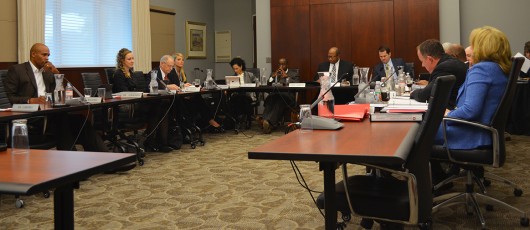
Credit: Robert Scarpinito
Finance
Jay Kasey, senior vice president for Administration and Planning, addressed the issue of campus crime at the Board’s Thursday finance committee meeting.
“We are running four incidents above our budget,” Kasey said. “ We’ve had a spike in campus vehicle crime. On off-campus crime, statistics show we are at about 70 (crimes) over our goal.”
Kasey said the Administration and Planning sector has put a new force of security agents in off-campus neighborhoods for improved safety.
Committee members also discussed the Comprehensive Transportation and Parking Plan, which is meant to enhance the university’s parking, transit and transportation systems.
The Comprehensive Transportation and Parking Plan includes making the university a “park once” campus with the implementation of an express shuttle service to parking lots. Stronger safety measures for bicyclists and pedestrians would also be enforced.
Academic affairs and student life
The recent outcomes of Discovery Themes — a $400 million plan to extend area-specific university research and bring in expert faculty — were highlighted by Executive Vice President and Provost Joseph Steinmetz at the academic affairs and student life committee meeting Thursday.
So far the university has posted 39 Discovery Theme-based faculty members and awarded funds to seven initial areas of investment, costing a total of $120 million, Steinmetz said.
Each of these faculty will contribute to and further the three overarching themes of energy and environment, food production and security, and health and wellness, he said.
“There’s been a tremendous amount of progress made,” Steinmetz said. “I like to think of what we’re doing as putting the meat on the bones of what the Discovery Themes are becoming.”
The 39 positions comprise approximately 21 percent of the 185 new faculty hires the Discovery Themes initiative projects to bring in by 2020.
The 2010-15 Enrollment Plan has met many of its goals, including an increase of total university enrollment, graduate student population and average student ACT scores, said Dolan Evanovich, vice president of strategic enrollment planning.
The university has also increased spending on both merit and need-based aid, but Evanovich’s data showed that funding for merit-based aid has been steadily higher than funding for need-based aid by more than $20 million for the past five years.
Amid these positive increases in student enrollment, there was a set of figures that the committee explored — the diversity of the student population. Between 2013-14, there was a decrease of in-state students who identify themselves as minorities, Evanovich said.
“We have to work hard to attract African-American students,” he said, noting that Ohio has a less ethnically diverse population than many Western and Southern states.
The committee also announced its approval of a mid-Fall Semester break, which needs final authorization from the entire Board on Friday, but if approved, would be implemented in 2015.
The break would consist of an extended weekend in the middle of Fall Semester, with a consecutive Thursday and Friday off, causing the semester’s classes to start one day earlier and to conclude one day later, according to the agenda.
Sarah Mikati also contributed to this story
Former Jay Leno producer shares ‘Tonight Show’ experiences with Ohio State students
Sept. 29, 2014
As co-producer of “The Tonight Show with Jay Leno” and “The Jay Leno Show” for a combined 18 years, Dave Berg helped shape late-night television with his experience in journalism by bringing in people from the political world, which ultimately contributed to one of the first environments where news and entertainment merged.

Berg came to Ohio State on Sept. 22 with his wife Mary, an OSU alumna, to speak about his experience with “The Tonight Show,” a period of time he also describes in his new book, “Behind the Curtain: An Insider’s View of Jay Leno’s Tonight Show.” He spoke to several journalism-related classes, including Comm 4202, a magazine-writing class taught by assistant clinical journalism professor Nicole Kraft, and Comm 2223, The Lantern practicum class taught by clinical assistant professor and director of student media Dan Caterinicchia.
In his speech to the classes, Berg touched on his background in journalism, notable experiences and how late-night television was the precursor to shows such as “The Daily Show,” where news and entertainment were coming to a lot of people from the same source, Kraft said. For instance, it was a shock to many people when actor Hugh Grant came on the show in 1995 and talked with Leno about how he was found with a prostitute.
“News wouldn’t have been broken that way when Jay Leno first did it,“ Kraft said. “He had the ability to instill a really important part of entertainment history into a very consumable form.”
Berg’s book was released in July, and he said its promotion is currently his priority. It took him roughly four years to put the book together and get it published, he said, but he wanted to take time to accurately tell the story of the show’s best and worst moments.
The book includes anecdotes about some of the show’s most well-known guests and gives an inside look on Leno’s work, which Berg said he wanted to highlight after Leno retired in February.
Berg’s predisposition to book prominent political figures seemed to make up for his lack of history in entertainment, with notable guest spots filled by Hillary Clinton, Joe Biden and Mitt Romney, among others. He said he wasn’t necessarily trying to do something different, but that it just made sense to push for guests he knew about.
“The interesting thing is that deep down inside, all political people want to be funny,” Berg said. “They’re kind of performers in their own right, and many of them understand how humor works.”
He noted that the worlds of Hollywood and Washington, D.C., are similar, and although the phrase “Washington is just Hollywood for ugly people,” is often attributed to Leno, Berg isn’t quite sure if it was he who actually coined it.
Leno’s show had some of the highest ratings in late-night television for nearly two decades, Berg said, because he and his team made efforts to appeal to the greatest quantity of people.
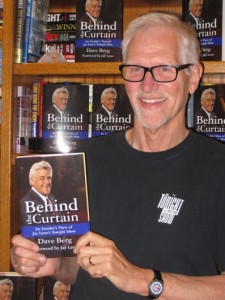
Mary Berg said because Dave was more conservative than his former colleagues, Leno would often refer to him to judge whether certain jokes had crossed the line.
Leno’s favorite guest was coincidentally Dave Berg’s favorite as well. This guest was someone whom many people considered to be “American royalty,” Dave Berg said. They promoted this icon as a “mystery guest” in 1998 because he didn’t want his name, John F. Kennedy Jr., released until the show aired.
“I thought, ‘Wow, this is a real human being, and (JFK Jr.) really is concerned and afraid of doing the segment,’” Dave Berg said. “I have never encountered a celebrity like that, who just didn’t think they were good enough, and he turned out to be the most charming, entertaining guest I’ve ever worked with.”
Dave Berg said he and JFK Jr. exchanged four total phone calls, each one lasting an hour, just to complete the pre-interview process, which was when Dave Berg guided booked guests in choosing and discussing topics for their segment with Leno.
One pivotal moment in the show’s life stood out not only for Dave Berg, but in the timeline of television history. That’s when Barack Obama was the first sitting president to ever appear on the late-night show, when he was interviewed by Jay Leno for a segment in 2009.
“I think Obama is probably better at humor than 90 percent of the Hollywood guests,” Dave Berg said. “And I’m not speaking ill of them at all, but he’s that good.”
After working around many celebrities, Berg said he doesn’t agree with the stereotypes about them having big egos or not caring about anyone but themselves. He said one of his biggest takeaways from the experience was learning that famous people are just that: people.
“Shows like TMZ are pretty popular today, and the way they portray celebrities and all the horrible things they do, but I happen to like most celebrities,” Dave Berg said. “Working with them changed me, not because they were high-powered, but just because it helped me to learn to be more sensitive to people. You had to learn to select your words carefully.”
After Berg was let go at NBC in the 1980s, he decided to apply for the “The Tonight Show” last-minute and ended up asking for the application less than an hour before NBC stopped accepting them. He had no idea he would be picked for the job, but now he said he wishes he would have tried to enjoy the process more while he was in the middle of it.
“You get taken in by the details each day, like the ratings or what guest just canceled at the last minute,” he said. “There just aren’t that many openings for producers on late-night shows, and I’ve considered it a total blessing that I got that job.”
Exhibit goes from the Wexner living room to the Wexner Center – *front-page story
Sept. 18, 2014
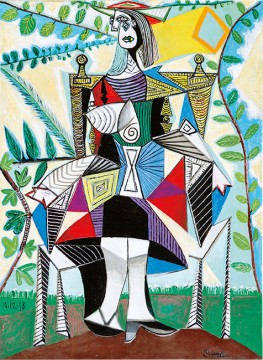
The home of L Brands chairman and chief executive Leslie Wexner and his wife, Abigail, is usually adorned with eminent artworks by Pablo Picasso, Jean Dubuffet and Alberto Giacometti, but those pieces — along with much of the Wexners’ personal art collection — have found new dwelling at Ohio State’s Wexner Center for the Arts.
About 60 works of art from the Wexners’ private collection have voyaged to the galleries of the Wexner Center for their first public debut in an exhibition that opens Sunday. The collection is centered on works of Picasso, Dubuffet and Giacometti, with about 15 works coming from each, but art by Susan Rothenberg, Willem de Kooning and Edgar Degas also play an important role in constituting the collection.
The exhibit, titled “Transfigurations: Modern Masters from the Wexner Family Collection,” lasts through Dec. 31 and is one of the ways that the Wexner Center — named after Leslie Wexner’s father, Harry — is celebrating its 25th anniversary.
“It’s a very interesting collection in many ways,” said Lisa Florman, chair of the Department of History of Art, and the instructor of a one-time class that will be studying the Wexner family collection in detail. “I still think Picasso’s works are the most spectacular in the show, but there are ways in which the other artists’ works are going to be a revelation to people.”
Guest curator of the exhibit Robert Storr, professor and dean of the Yale University School of Art and previous senior curator of painting and sculpture at the Museum of Modern Art in Manhattan, comes to the exhibit with a deep and important background in art history, said Jennifer Wray, marketing and media assistant at the Wexner Center.
The works in the collection, which range in date from 1898-99 to the 1950s but mainly focus on post-war European art, each explore a common concept: the figure. Anybody who wanted to be considered a significant artist after 1945 in the United States was doing abstract works, but that wasn’t the case in Europe, Florman said.
“Abstract paintings were still being made, but there were also really significant artists like Picasso, Giacometti and Dubuffet who were insistent that modern art could be representational and figurative. The tradition of the human figure lived on longer in Europe,” Florman said.
The earliest piece in the exhibit is a charcoal sketch informally titled “Spanish Village Scene” and was created by Picasso when he was a mere 17 years of age.
“One of the things I always have to get my students to wrap their heads around is how extraordinarily talented he was from a very early age,” Florman said. “We tend to think of artists’ style or technique developing over time, but Picasso is a little different in that he could be working in two unrelated styles almost simultaneously.”
Hanging on a wall all to itself, Picasso’s “Nude in a Black Armchair” is what many would consider to be the most prized and renowned work in the exhibit. Picasso put paint to canvas to create this striking vision in 1932, and 67 years later, Leslie Wexner purchased it for $45.1 million, according to The Columbus Dispatch.
“It truly is a showstopper,” Florman said. “And there are a number of works from the collection I would put in the same category, but the collectors are courageous in that they didn’t simply choose the easiest, prettiest works they could have. There are some really challenging and difficult-to-look-at paintings in there, and it’s admirable.”
Leslie Wexner initially began his collection in the 1970s by acquiring works by a variety of artists, but some years later, he became captivated by Picasso’s work while observing it at an art fair, according to The Wall Street Journal. This changed the trajectory to his approach to collecting art, and the results can be seen in the exhibit.
Students in Florman’s class, History 5001: Transfigurations of (and in) Twentieth-Century Art, are getting the chance to spend a few times a week in the galleries with this rarely seen art and will eventually present a seminar in December on what they’ve learned.
Florman didn’t have plans to teach this semester, but when she found out that works of this caliber would be available to her students, she said she couldn’t pass up the rare opportunity.
It was essential to the Wexners that, in addition to the Columbus community at large, students of all ages get a chance to understand and interact with the artwork, said Shelly Casto, the director of education at the Wexner Center.
In order to meet these needs in an era where arts budgets are cut first in schools, the Wexner Center has taken the initiative to provide free busing for any K-12 school that wants to visit the exhibit, along with providing a plethora of educational components, Wray said.
One gallery in the exhibit has been transformed via touch-screen interfaces that people can interact with and pull up images of works both in the show and elsewhere to do some comparing, contrasting and exploring. Other multimedia components include a continuous loop of video interviews with artists and architects discussing the ongoing influence of these artists and with the Wexners themselves, Wray said.
There are also a number of events occurring in conjunction with the exhibit throughout the next three months, including film screenings and talks with distinguished artists, critics and art historians — the most notable being T.J. Clark and Joshua Wolf Shenk.
Picasso’s granddaughter, Diana Widmaier-Picasso, will be coming from Europe for the opening celebration in addition to having her writing featured in the exhibit’s comprehensive catalog, alongside essays of Storr and Florman.
“Widmaier-Picasso is an eminent art scholar in her own right,” Wray said. “She’s dedicated a lot of her work to analyzing and preserving her grandfather’s artistic legacy.”
Gallery admission is $8 for the general public, $6 for OSU faculty, staff or anyone 65 and older, and free for any college student with an ID or those under the age of 18. Each ticket has a set time and can be reserved online, after which the holder can enter the galleries for as long as they wish.
